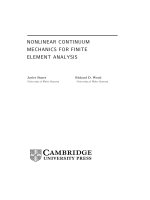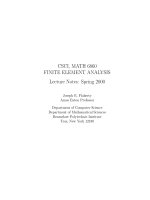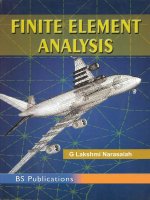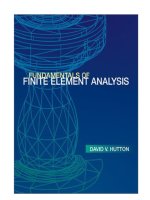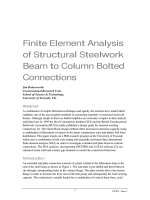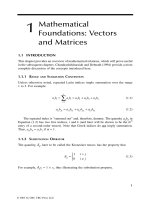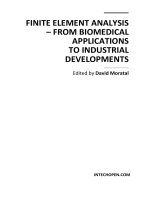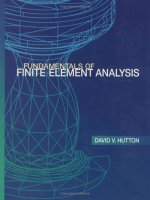finite element analysis - introd
Bạn đang xem bản rút gọn của tài liệu. Xem và tải ngay bản đầy đủ của tài liệu tại đây (3.87 MB, 323 trang )
CSCI, MATH 6860
FINITE ELEMENT ANALYSIS
Lecture Notes: Spring 2000
Joseph E. Flaherty
Amos Eaton Professor
Department of Computer Science
Department of Mathematical Sciences
Rensselaer Polytechnic Institute
Troy, New York 12180
c 2000, Joseph E. Flaherty, all rights reserved. These notes are intended for classroom
use by Rensselaer students taking courses CSCI, MATH 6860. Copying or downloading
by others for personal use is acceptable with noti cation of the author.
ii
CSCI, MATH 6860: Finite Element Analysis
Spring 2000
Outline
1. Introduction
1.1. Historical Perspective
1.2. Weighted Residual Methods
1.3. A Simple Finite Element Problem
2. One-Dimensional Finite Element Methods
2.1.
2.2.
2.3.
2.4.
2.5.
2.6.
Introduction
Galerkin's Method and Extremal Principles
Essential and Natural Boundary Conditions
Piecewise Lagrange Approximation
Hierarchical Bases
Interpolation Errors
3. Multi-Dimensional Variational Principles
3.1. Galerkin's Method and Extremal Principles
3.2. Function Spaces and Approximation
3.3. Overview of the Finite Element Method
4. Finite Element Approximation
4.1.
4.2.
4.3.
4.4.
4.5.
4.6.
Introduction
Lagrange Bases on Triangles
Lagrange Bases on Rectangles
Hierarchical Bases
Three-dimensional Bases
Interpolation Errors
5. Mesh Generation and Assembly
5.1. Introduction
iii
5.2.
5.3.
5.4.
5.5.
5.6.
Mesh Generation
Data Structures
Coordinate Transformations
Generation of Element Matrices and Their Assembly
Assembly of Vector Systems
6. Numerical Integration
6.1. Introduction
6.2. One-Dimensional Gaussian Quadrature
6.3. Multi-Dimensional Gaussian Quadrature
7. Discretization Errors
7.1. Introduction
7.2. Convergence and Optimality
7.3. Perturbations
8. Adaptivity
8.1. Introduction
8.2. h-Re nement
8.3. p- and hp-Re nement
9. Parabolic Problems
9.1.
9.2.
9.3.
9.4.
9.5.
Introduction
Semi-Discrete Galerkin Methods: The Method of Lines
Finite Element Methods in Time
Convergence and Stability
Convection-Di usion Systems
10. Hyperbolic Problems
10.1. Introduction
10.2. Flow Problems and Upwind Weighting
10.3. Arti cial Di usion
iv
10.4. Streamline Weighting
11. Linear Systems Solution
11.1.
11.2.
11.3.
11.4.
11.5.
Introduction
Banded Gaussian Elimination and Pro le Techniques
Nested Dissection and Domain Decomposition
Conjugate Gradient Methods
Nonlinear Problems and Newton's Method
v
vi
Bibliography
1] A.K. Aziz, editor. The Mathematical Foundations of the Finite Element Method with
Applications to Partial Di erential Equations, New York, 1972. Academic Press.
2] I. Babuska, J. Chandra, and J.E. Flaherty, editors. Adaptive Computational Methods
for Partial Di erential Equations, Philadelphia, 1983. SIAM.
3] I. Babuska, O.C. Zienkiewicz, J. Gago, and E.R. de A. Oliveira, editors. Accuracy
Estimates and Adaptive Re nements in Finite Element Computations. John Wiley
and Sons, Chichester, 1986.
4] K.-J. Bathe. Finite Element Procedures. Prentice Hall, Englewood Cli s, 1995.
5] E.B. Becker, G.F. Carey, and J.T. Oden. Finite Elements: An Introduction, volume I. Prentice Hall, Englewood Cli s, 1981.
6] M.W. Bern, J.E. Flaherty, and M. Luskin, editors. Grid Generation and Adaptive
Algorithms, volume 113 of The IMA Volumes in Mathematics and its Applications,
New York, 1999. Springer.
7] C.A. Brebia. The Boundary Element Method for Engineers. Pentech Press, London,
second edition, 1978.
8] S.C. Brenner and L.R. Scott. The Mathematical Theory of Finite Element Methods.
Springer-Verlag, New York, 1994.
9] G.F. Carey. Computational Grids: Generation, Adaptation, and Solution Strategies.
Series in Computational and Physical Processes in Mechanics and Thermal science.
Taylor and Francis, New York, 1997.
10] G.F. Carey and J.T. Oden. Finite Elements: A Second Course, volume II. Prentice
Hall, Englewood Cli s, 1983.
11] G.F. Carey and J.T. Oden. Finite Elements: Computational Aspects, volume III.
Prentice Hall, Englewood Cli s, 1984.
vii
12] P.G. Ciarlet. The Finite Element Method for Elliptic Problems. North-Holland,
Amsterdam, 1978.
13] K. Clark, J.E. Flaherty, and M.S. Shephard, editors. Applied Numerical Mathematics, volume 14, 1994. Special Issue on Adaptive Methods for Partial Di erential
Equations.
14] R.D. Cook, D.S. Malkus, and M.E. Plesha. Concepts and Applications of Finite
Element Analysis. John Wiley and Sons, New York, third edition, 1989.
15] K. Eriksson, D. Estep, P. Hansbo, and C. Johnson. Computational Di erential
Equation. Cambridge, Cambridge, 1996.
16] G. Fairweather. Finite Element Methods for Di erential Equations. Marcel Dekker,
Basel, 1981.
17] B. Finlayson. The Method of Weighted Residuals and Variational Principles. Academic Press, New York, 1972.
18] J.E. Flaherty, P.J. Paslow, M.S. Shephard, and J.D. Vasilakis, editors. Adaptive
methods for Partial Di erential Equations, Philadelphia, 1989. SIAM.
19] R.H. Gallagher, J.T. Oden, C. Taylor, and O.C. Zienkiewicz, editors. Finite Elements in Fluids: Mathematical Foundations, Aerodynamics and Lubrication, volume 2, London, 1975. John Wiley and Sons.
20] R.H. Gallagher, J.T. Oden, C. Taylor, and O.C. Zienkiewicz, editors. Finite Elements in Fluids: Viscous Flow and Hydrodynamics, volume 1, London, 1975. John
Wiley and Sons.
21] R.H. Gallagher, O.C. Zienkiewicz, J.T. Oden, M. Morandi Cecchi, and C. Taylor,
editors. Finite Elements in Fluids, volume 3, London, 1978. John Wiley and Sons.
22] V. Girault and P.A. Raviart. Finite Element Approximations of the Navier-Stokes
Equations. Number 749 in Lecture Notes in Mathematics. Springer-Verlag, Berlin,
1979.
23] T.J.R. Hughes, editor. Finite Element Methods for Convection Dominated Flows,
volume 34 of AMD, New York, 1979. ASME.
24] T.J.R. Hughes. The Finite Element Method: Linear Static and Dynamic Finite
Element Analysis. Prentice Hall, Englewood Cli s, 1987.
viii
25] B.M. Irons and S. Ahmed. Techniques of Finite Elements. Ellis Horwood, London,
1980.
26] C. Johnson. Numerical Solution of Partial Di erential Equations by the Finite Element method. Cambridge, Cambridge, 1987.
27] N. Kikuchi. Finite Element Methods in Mechanics. Cambridge, Cambridge, 1986.
28] Y.W. Kwon and H. Bang. The Finite Element Method Using Matlab. CRC Mechanical Engineering Series. CRC, Boca Raton, 1996.
29] L. Lapidus and G.F. Pinder. Numerical Solution of Partial Di erential Equations
in Science and Engineering. Wiley-Interscience, New York, 1982.
30] D.L. Logan. A First Course in the Finite Element Method using ALGOR. PWS,
Boston, 1997.
31] J.T. Oden. Finite Elements of Nonlinear Continua. Mc Graw-Hill, New York, 1971.
32] J.T. Oden and G.F. Carey. Finite Elements: Mathematical Aspects, volume IV.
Prentice Hall, Englewood Cli s, 1983.
33] D.R.J. Owen and E. Hinton. Finite Elements in Plasticity-Theory and Practice.
Pineridge, Swansea, 1980.
34] D.D. Reddy and B.D. Reddy. Introductory Functional Analysis: With Applications
to Boundary Value Problems and Finite Elements. Number 27 in Texts in Applied
Mathematics. Springer-Verlag, Berlin, 1997.
35] J.N. Reddy. The Finite Element Method in Heat Transfer and Fluid Dynamics.
CRC, Boca Raton, 1994.
36] C. Schwab. P- And Hp- Finite Element Methods: Theory and Applications in Solid
and Fluid Mechanics. Numerical Mathematics and Scienti c Computation. Clarendon, London, 1999.
37] G. Strang and G. Fix. Analysis of the Finite Element Method. Prentice-Hall, Englewood Cli s, 1973.
38] B. Szabo and I. Babuska. Finite Element Analysis. John Wiley and Sons, New York,
1991.
39] F. Thomasset. Implementation of Finite Element Methods for Navier-Stokes Equations. Springer Series in Computational Physics. Springer-Verlag, New York, 1981.
ix
40] V. Thomee. Galerkin Finite Element Methods for Parabolic Problems. Number 1054
in Lecture Notes in Mathematics. Springer-Verlag, Berlin, 1984.
41] R. Verfurth. A Review of Posteriori Error Estimation and Adaptive MeshRe nement Techniques. Teubner-Wiley, Stuttgart, 1996.
42] R. Vichevetsky. Computer Methods for Partial Di erential Equations: Elliptic Equations and the Finite-Element Method, volume 1. Prentice-Hall, Englewood Cli s,
1981.
43] R. Wait and A.R. Mitchell. The Finite Element Analysis and Applications. John
Wiley and Sons, Chichester, 1985.
44] R.E. White. An Introduction to the Finite Element Method with Applications to
Nonlinear Problems. John Wiley and Sons, New York, 1985.
45] J.R. Whiteman, editor. The Mathematics of Finite Elements and Applications V,
MAFELAP 1984, London, 1985. Academic Press.
46] J.R. Whiteman, editor. The Mathematics of Finite Elements and Applications VI,
MAFELAP 1987, London, 1988. Academic Press.
47] O.C. Zienkiewicz. The Finite Element Method. Mc Graw-Hill, New York, third
edition, 1977.
48] O.C. Zienkiewicz and R.L. Taylor. Finite Element Method: Solid and Fluid Mechanics Dynamics and Non-Linearity. Mc Graw-Hill, New York, 1991.
x
Chapter 1
Introduction
1.1 Historical Perspective
The nite element method is a computational technique for obtaining approximate solutions to the partial di erential equations that arise in scienti c and engineering applications. Rather than approximating the partial di erential equation directly as with, e.g.,
nite di erence methods, the nite element method utilizes a variational problem that
involves an integral of the di erential equation over the problem domain. This domain
is divided into a number of subdomains called nite elements and the solution of the
partial di erential equation is approximated by a simpler polynomial function on each
element. These polynomials have to be pieced together so that the approximate solution
has an appropriate degree of smoothness over the entire domain. Once this has been
done, the variational integral is evaluated as a sum of contributions from each nite element. The result is an algebraic system for the approximate solution having a nite
size rather than the original in nite-dimensional partial di erential equation. Thus, like
nite di erence methods, the nite element process has discretized the partial di erential equation but, unlike nite di erence methods, the approximate solution is known
throughout the domain as a pieceise polynomial function and not just at a set of points.
Logan 10] attributes the discovery of the nite element method to Hrennikof 8] and
McHenry 11] who decomposed a two-dimensional problem domain into an assembly of
one-dimensional bars and beams. In a paper that was not recognized for several years,
Courant 6] used a variational formulation to describe a partial di erential equation with
a piecewise linear polynomial approximation of the solution relative to a decomposition of
the problem domain into triangular elements to solve equilibrium and vibration problems.
This is essentially the modern nite element method and represents the rst application
where the elements were pieces of a continuum rather than structural members.
Turner et al. 13] wrote a seminal paper on the subject that is widely regarded
1
2
Introduction
as the beginning of the nite element era. They showed how to solve one- and twodimensional problems using actual structural elements and triangular- and rectangularelement decompositions of a continuum. Their timing was better than Courant's 6],
since success of the nite element method is dependent on digital computation which
was emerging in the late 1950s. The concept was extended to more complex problems
such as plate and shell deformation (cf. the historical discussion in Logan 10], Chapter
1) and it has now become one of the most important numerical techniques for solving
partial di erential equations. It has a number of advantages relative to other methods,
including
the treatment of problems on complex irregular regions,
the use of nonuniform meshes to re ect solution gradations,
the treatment of boundary conditions involving uxes, and
the construction of high-order approximations.
Originally used for steady (elliptic) problems, the nite element method is now used
to solve transient parabolic and hyperbolic problems. Estimates of discretization errors
may be obtained for reasonable costs. These are being used to verify the accuracy of the
computation, and also to control an adaptive process whereby meshes are automatically
re ned and coarsened and/or the degrees of polynomial approximations are varied so as
to compute solutions to desired accuracies in an optimal fashion 1, 2, 3, 4, 5, 7, 14].
1.2 Weighted Residual Methods
Our goal, in this introductory chapter, is to introduce the basic principles and tools of
the nite element method using a linear two-point boundary value problem of the form
L u] := ;
d (p(x) du ) + q(x)u = f (x)
dx
dx
u(0) = u(1) = 0:
0
(1.2.1a)
(1.2.1b)
The nite element method is primarily used to address partial di erential equations and is
hardly used for two-point boundary value problems. By focusing on this problem, we hope
to introduce the fundamental concepts without the geometric complexities encountered
in two and three dimensions.
Problems like (1.2.1) arise in many situations including the longitudinal deformation
of an elastic rod, steady heat conduction, and the transverse de ection of a supported
1.2. Weighted Residual Methods
3
cable. In the latter case, for example, u(x) represents the lateral de ection at position
x of a cable having (scaled) unit length that is subjected to a tensile force p, loaded by
a transverse force per unit length f (x), and supported by a series of springs with elastic
modulus q (Figure 1.2.1). The situation resembles the cable of a suspension bridge. The
tensile force p is independent of x for the assumed small deformations of this model, but
the applied loading and spring moduli could vary with position.
p
11
00
11
00
11
00
11
00
q(x)
p
x
u(x)
f(x)
Figure 1.2.1: De ection u of a cable under tension p, loaded by a force f per unit length,
and supported by springs having elastic modulus q.
Mathematically, we will assume that p(x) is positive and continuously di erentiable
for x 2 0 1], q(x) is non-negative and continuous on 0 1], and f (x) is continuous on
0 1].
Even problems of this simplicity cannot generally be solved in terms of known functions thus, the rst topic on our agenda will be the development of a means of calculating
approximate solutions of (1.2.1). With nite di erence techniques, derivatives in (1.2.1a)
are approximated by nite di erences with respect to a mesh introduced on 0 1] 12].
With the nite element method, the method of weighted residuals (MWR) is used to
construct an integral formulation of (1.2.1) called a variational problem. To this end, let
us multiply (1.2.1a) by a test or weight function v and integrate over (0 1) to obtain
(v L u] ; f ) = 0:
(1.2.2a)
We have introduced the L2 inner product
(v u) :=
Z
1
0
vudx
(1.2.2b)
to represent the integral of a product of two functions.
The solution of (1.2.1) is also a solution of (1.2.2a) for all functions v for which the
inner product exists. We'll express this requirement by writing v 2 L2(0 1). All functions
of class L2(0 1) are \square integrable" on (0 1) thus, (v v) exists. With this viewpoint
and notation, we write (1.2.2a) more precisely as
(v L u] ; f ) = 0
8v 2 L2 (0 1):
(1.2.2c)
4
Introduction
Equation (1.2.2c) is referred to as a variational form of problem (1.2.1). The reason for
this terminology will become clearer as we develop the topic.
Using the method of weighted residuals, we construct approximate solutions by replacing u and v by simpler functions U and V and solving (1.2.2c) relative to these
choices. Speci cally, we'll consider approximations of the form
u(x) U (x) =
v(x) V (x) =
N
X
j =1
N
X
j =1
cj j (x)
(1.2.3a)
dj j (x):
(1.2.3b)
The functions j (x) and j (x), j = 1 2 : : : N , are preselected and our goal is to
determine the coe cients cj , j = 1 2 : : : N , so that U is a good approximation of u.
For example, we might select
j (x) = j (x) = sin j
x
j = 1 2 ::: N
to obtain approximations in the form of discrete Fourier series. In this case, every function
satis es the boundary conditions (1.2.1b), which seems like a good idea.
The approximation U is called a trial function and, as noted, V is called a test function. Since the di erential operator L u] is second order, we might expect u 2 C 2 (0 1).
(Actually, u can be slightly less smooth, but C 2 will su ce for the present discussion.)
Thus, it's natural to expect U to also be an element of C 2(0 1). Mathematically, we regard U as belonging to a nite-dimensional function space that is a subspace of C 2 (0 1).
We express this condition by writing U 2 S N (0 1) C 2(0 1). (The restriction of these
functions to the interval 0 < x < 1 will, henceforth, be understood and we will no longer
write the (0 1).) With this interpretation, we'll call S N the trial space and regard the
preselected functions j (x), j = 1 2 : : : N , as forming a basis for S N .
Likewise, since v 2 L2, we'll regard V as belonging to another nite-dimensional
^
^
function space S N called the test space. Thus, V 2 S N L2 and j (x), j = 1 2 : : : N ,
^
provide a basis for S N .
Now, replacing v and u in (1.2.2c) by their approximations V and U , we have
(V
L U] ; f) = 0
^
8V 2 S N :
(1.2.4a)
The residual
r(x) := L U ] ; f (x)
(1.2.4b)
1.2. Weighted Residual Methods
5
is apparent and clari es the name \method of weighted residuals." The vanishing of the
inner product (1.2.4a) implies that the residual is orthogonal in L2 to all functions V in
^
the test space S N .
Substituting (1.2.3) into (1.2.4a) and interchanging the sum and integral yields
N
X
j =1
dj (
j L U] ; f) = 0
8dj
j = 1 2 : : : N:
(1.2.5)
Having selected the basis j , j = 1 2 : : : N , the requirement that (1.2.4a) be satis ed for
^
all V 2 S N implies that (1.2.5) be satis ed for all possible choices of dk , k = 1 2 : : : N .
This, in turn, implies that
(
j L U] ; f) = 0
j = 1 2 : : : N:
(1.2.6)
Shortly, by example, we shall see that (1.2.6) represents a linear algebraic system for the
unknown coe cients ck , k = 1 2 : : : N .
^
One obvious choice is to select the test space S N to be the same as the trial space
and use the same basis for each thus, k (x) = k (x), k = 1 2 : : : N . This choice leads
to Galerkin's method
(
j L u] ; f ) = 0
j = 1 2 ::: N
(1.2.7)
which, in a slightly di erent form, will be our \work horse." With j 2 C 2, j =
1 2 : : : N , the test space clearly has more continuity than necessary. Integrals like
(1.2.4) or (1.2.6) exist for some pretty \wild" choices of V . Valid methods exist when V
is a Dirac delta function (although such functions are not elements of L2 ) and when V
is a piecewise constant function (cf. Problems 1 and 2 at the end of this section).
There are many reasons to prefer a more symmetric variational form of (1.2.1) than
(1.2.2), e.g., problem (1.2.1) is symmetric (self-adjoint) and the variational form should
re ect this. Additionally, we might want to choose the same trial and test spaces, as with
Galerkin's method, but ask for less continuity on the trial space S N . This is typically
the case. As we shall see, it will be di cult to construct continuously di erentiable
approximations of nite element type in two and three dimensions. We can construct
the symmetric variational form that we need by integrating the second derivative terms
in (1.2.2a) by parts thus, using (1.2.1a)
Z1
v ;(pu ) + qu ; f ]dx =
0
0
Z
1
0
(v pu + vqu ; vf )dx ; vpu j1 = 0
0
0
0
0
0
(1.2.8)
where ( ) = d( )=dx. The treatment of the last (boundary) term will need greater
attention. For the moment, let v satisfy the same trivial boundary conditions (1.2.1b) as
0
6
Introduction
u. In this case, the boundary term vanishes and (1.2.8) becomes
A(v u) ; (v f ) = 0
where
A(v u) =
Z
1
(v pu + vqu)dx:
0
0
0
(1.2.9a)
(1.2.9b)
The integration by parts has eliminated second derivative terms from the formulation.
Thus, solutions of (1.2.9) might have less continuity than those satisfying either (1.2.1) or
(1.2.2). For this reason, they are called weak solutions in contrast to the strong solutions
of (1.2.1) or (1.2.2). Weak solutions may lack the continuity to be strong solutions, but
strong solutions are always weak solutions. In situations where weak and strong solutions
di er, the weak solution is often the one of physical interest.
Since we've added a derivative to v by the integration by parts, v must be restricted
to a space where functions have more continuity than those in L2 . Having symmetry in
mind, we will select functions u and v that produce bounded values of
A(u u) =
Z1
p(u )2 + qu2]dx:
0
0
Actually, since p and q are smooth functions, it su ces for u and v to have bounded
values of
Z
1
(u )2 + u2]dx:
0
0
(1.2.10)
Functions where (1.2.10) exists are said to be elements of the Sobolev space H 1. We've
also required that u and v satisfy the boundary conditions (1.2.1b). We identify those
functions in H 1 that also satisfy (1.2.1b) as being elements of H01. Thus, in summary,
the variational problem consists of determining u 2 H01 such that
A(v u) = (v f )
1
8v 2 H0 :
(1.2.11)
The bilinear form A(v u) is called the strain energy. In mechanical systems it frequently
corresponds to the stored or internal energy in the system.
We obtain approximate solutions of (1.2.11) in the manner described earlier for the
more general method of weighted residuals. Thus, we replace u and v by their approximations U and V according to (1.2.3). Both U and V are regarded as belonging to the
N
same nite-dimensional subspace S0 of H01 and j , j = 1 2 : : : N , forms a basis for
S0N . Thus, U is determined as the solution of
A( V U ) = ( V f )
N
8V 2 S0 :
(1.2.12a)
1.2. Weighted Residual Methods
7
The substitution of (1.2.3b) with
explicit form
j
replaced by
A( j U ) = ( j f )
in (1.2.12a) again reveals the more
j
j = 1 2 : : : N:
(1.2.12b)
Finally, to make (1.2.12b) totally explicit, we eliminate U using (1.2.3a) and interchange
a sum and integral to obtain
N
X
k=1
ck A(
j
k) = ( j
f)
j = 1 2 : : : N:
(1.2.12c)
Thus, the coe cients ck , k = 1 2 : : : N , of the approximate solution (1.2.3a) are determined as the solution of the linear algebraic equation (1.2.12c). Di erent choices of the
basis j , j = 1 2 : : : N , will make the integrals involved in the strain energy (1.2.9b)
and L2 inner product (1.2.2b) easy or di cult to evaluate. They also a ect the accuracy
of the approximate solution. An example using a nite element basis is presented in the
next section.
Problems
1. Consider the variational form (1.2.6) and select
j (x) =
(x ; xj )
j = 1 2 ::: N
where (x) is the Dirac delta function satisfying
(x) = 0
x 6= 0
Z
1
(x)dx = 1
;1
and
0 < x1 < x2 < : : : < xN < 1:
Show that this choice of test function leads to the collocation method
L U ] ; f (x)jx=xj
=0
j = 1 2 : : : N:
Thus, the di erential equation (1.2.1) is satis ed exactly at N distinct points on
(0 1).
2. The subdomain method uses piecewise continuous test functions having the basis
1 if x 2 (xj 1=2 xj+1=2) :
j (x) := 0 otherwise
where xj 1=2 = (xj + xj 1)=2. Using (1.2.6), show that the approximate solution
U (x) satis es the di erential equation (1.2.1a) on the average on each subinterval
(xj 1=2 xj+1=2), j = 1 2 : : : N .
;
;
;
;
8
Introduction
3. Consider the two-point boundary value problem
;u
00
+u=x
which has the exact solution
0
u(0) = u(1) = 0
u(x) = x ; sinh x :
sinh 1
Solve this problem using Galerkin's method (1.2.12c) using the trial function
U (x) = c1 sin x:
Thus, N = 1, 1(x) = 1 (x) = sin x in (1.2.3). Calculate the error in strain
energy as A(u u) ; A(U U ), where A(u v) is given by (1.2.9b).
1.3 A Simple Finite Element Problem
Finite element methods are weighted residuals methods that use bases of piecewise polynomials having small support. Thus, the functions (x) and (x) of (1.2.3, 1.2.4) are
nonzero only on a small portion of problem domain. Since continuity may be di cult to
impose, bases will typically use the minimum continuity necessary to ensure the existence
of integrals and solution accuracy. The use of piecewise polynomial functions simplify
the evaluation of integrals involved in the L2 inner product and strain energy (1.2.2b,
1.2.9b) and help automate the solution process. Choosing bases with small support leads
to a sparse, well-conditioned linear algebraic system (1.2.12c)) for the solution.
Let us illustrate the nite element method by solving the two-point boundary value
problem (1.2.1) with constant coe cients, i.e.,
;pu
00
+ qu = f (x)
0
u(0) = u(1) = 0
(1.3.1)
where p > 0 and q 0. As described in Section 1.2, we construct a variational form of
(1.2.1) using Galerkin's method (1.2.11). For this constant-coe cient problem, we seek
to determine u 2 H01 satisfying
A(v u) = (v f )
where
(v u) =
A(v u) =
Z
1
1
8v 2 H0
Z1
0
(v pu + vqu)dx:
0
0
vudx
0
(1.3.2a)
(1.3.2b)
(1.3.2c)
1.3. A Simple Finite Element Problem
9
With u and v belonging to H01, we are sure that the integrals (1.3.2b,c) exist and that
the trivial boundary conditions are satis ed.
We will subsequently show that functions (of one variable) belonging to H 1 must
necessarily be continuous. Accepting this for the moment, let us establish the goal of
nding the simplest continuous piecewise polynomial approximations of u and v. This
would be a piecewise linear polynomial with respect to a mesh
0 = x0 < x1 < : : : < xN = 1
(1.3.3)
introduced on 0 1]. Each subinterval (xj 1 xj ), j = 1 2 : : : N , is called a nite element.
The basis is created from the \hat function"
8 x x ;1
> x x ;1 if xj 1 x < xj
<
+1
(x) = > xx +1 xx if xj x < xj+1 :
(1.3.4a)
j
:0
otherwise
;
;
j
;
j; j
;
j
j
;
j
φ j (x)
1
x
x0
xj-1
xj
xj+1
xN
Figure 1.3.1: One-dimensional nite element mesh and piecewise linear hat function
j (x).
As shown in Figure 1.3.1, j (x) is nonzero only on the two elements containing the
node xj . It rises and descends linearly on these two elements and has a maximal unit
value at x = xj . Indeed, it vanishes at all nodes but xj , i.e.,
1 if xk = xj
(1.3.4b)
j (xk ) = jk := 0 otherwise :
Using this basis with (1.2.3), we consider approximations of the form
U (x) =
Let's examine this result more closely.
N 1
X
;
j =1
cj j (x):
(1.3.5)
10
Introduction
U(x)
cj
cj-1
cj+1
φj-1 (x)
1
φj (x)
x
x0
xj-1
xj
xj+1
xN
Figure 1.3.2: Piecewise linear nite element solution U (x).
1. Since each j (x) is a continuous piecewise linear function of x, their summation
U is also continuous and piecewise linear. Evaluating U at a node xk of the mesh
using (1.3.4b) yields
U (xk ) =
N 1
X
;
j =1
cj j (xk ) = ck :
Thus, the coe cients ck , k = 1 2 : : : N ; 1, are the values of U at the interior
nodes of the mesh (Figure 1.3.2).
2. By selecting the lower and upper summation indices as 1 and N ; 1 we have ensured
that (1.3.5) satis es the prescribed boundary conditions
U (0) = U (1) = 0:
As an alternative, we could have added basis elements
approximation and written the nite element solution as
U (x) =
N
X
j =0
0
(x) and
cj j (x):
N (x)
to the
(1.3.6)
Since, using (1.3.4b), U (x0 ) = c0 and U (xN ) = cN , the boundary conditions are
satis ed by requiring c0 = cN = 0. Thus, the representations (1.3.5) or (1.3.6) are
identical however, (1.3.6) would be useful with non-trivial boundary data.
3. The restriction of the nite element solution (1.3.5) or (1.3.6) to the element
xj 1 xj ] is the linear function
;
U (x) = cj
1
;
j
1
;
(x) + cj j (x)
x 2 xj 1 xj ]
;
(1.3.7)
1.3. A Simple Finite Element Problem
since
j
1
;
and
11
are the only nonzero basis elements on xj
j
;
1
xj ] (Figure 1.3.2).
Using Galerkin's method in the form (1.2.12c), we have to solve
N 1
X
;
ck A(
k=1
j
k) = ( j
f)
j = 1 2 : : : N ; 1:
(1.3.8)
Equation (1.3.8) can be evaluated in a straightforward manner by substituting replacing
k and j using (1.3.4) and evaluating the strain energy and L2 inner product according
to (1.3.2b,c). This development is illustrated in several texts (e.g., 9], Section 1.2).
We'll take a slightly more complex path to the solution in order to focus on the computer
implementation of the nite element method. Thus, write (1.2.12a) as the summation of
contributions from each element
N
X
j =1
N
8V 2 S0
Aj (V U ) ; (V f )j ] = 0
(1.3.9a)
where
Aj (V U ) = AS (V U ) + AM (V U )
j
j
AS (V
j
U) =
AM (V
j
Z
U) =
(V f )j =
xj
pV U dx
(1.3.9c)
qV Udx
(1.3.9d)
V fdx:
(1.3.9e)
0
xj;1
Zx
j
xj;1
Zx
j
xj;1
(1.3.9b)
0
It is customary to divide the strain energy into two parts with AS arising from internal
j
energies and AM arising from inertial e ects or sources of energy.
j
Matrices are simple data structures to manipulate on a computer, so let us write the
restriction of U (x) to xj 1 xj ] according to (1.3.7) as
;
U (x) = cj 1 cj ]
;
j
(x) =
j (x)
;
1
j
;
1
(x)
j (x)]
cj 1
cj
;
x 2 xj 1 xj ]: (1.3.10a)
;
We can, likewise, use (1.2.3b) to write the restriction of the test function V (x) to xj 1 xj ]
in the same form
1(
j
V (x) = dj 1 dj ] j (xx) = j 1(x) j (x)] dd 1
x 2 xj 1 xj ]: (1.3.10b)
)
j
j
;
;
;
;
;
;
12
Introduction
Our task is to substitute (1.3.10) into (1.3.9c-e) and evaluate the integrals. Let us begin
by di erentiating (1.3.10a) while using (1.3.4a) to obtain
U (x) = cj 1 cj ]
0
;
;1=hj
= ;1=hj 1=hj ] cjc 1
j
x 2 xj 1 xj ]:
;
1=hj
;
(1.3.11a)
where
hj = xj ; xj
Thus, U (x) is constant on xj
;
j = 1 2 : : : N:
1
(1.3.11b)
xj ] and is given by the rst divided di erence
U (x) = cj ; cj 1
x 2 xj 1 xj ]:
hj
Substituting (1.3.11) and a similar expression for V (x) into (1.3.9b) yields
Zx
S (V U ) =
Aj
p dj 1 dj ] ;1=hj ;1=hj 1=hj ] cjc 1 dx
1=hj
j
x ;1
0
1
;
;
0
;
0
j
;
;
j
or
AS (V U ) = dj 1 dj ]
j
;
Z
xj
xj;1
!
1=hj
p ;1=h2 ;1=hj2 dx cjc 1 :
1=hj
j
j
2
2
;
The integrand is constant and can be evaluated to yield
p
Kj = h
AS (V U ) = dj 1 dj ]Kj cjc 1
j
j
;
;
j
1
;1
;1
1 :
(1.3.12)
The 2 2 matrix Kj is called the element sti ness matrix. It depends on j through hj ,
but would also have such dependence if p varied with x. The key observation is that
Kj can be evaluated without knowing cj 1, cj , dj 1, or dj and this greatly simpli es the
automation of the nite element method.
The evaluation of AM proceeds similarly by substituting (1.3.10) into (1.3.9d) to
j
obtain
Zx
M (V U ) =
Aj
q dj 1 dj ] j 1 j 1 j ] cjc 1 dx:
;
;
j
;
xj;1
j
;
;
;
j
With q a constant, the integrand is a quadratic polynomial in x that may be integrated
exactly (cf. Problem 1 at the end of this section) to yield
AM (V U ) = dj 1 dj ]Mj cj 1cj
j
;
;
Mj = qhj 2 1
6 1 2
(1.3.13)
where Mj is called the element mass matrix because, as noted, it often arises from inertial
loading.
1.3. A Simple Finite Element Problem
13
The nal integral (1.3.9e) cannot be evaluated exactly for arbitrary functions f (x).
Without examining this matter carefully, let us approximate it by its linear interpolant
f (x) fj
1
;
j
;
1
(x) + fj j (x)
x 2 xj 1 xj ]
(1.3.14)
;
where fj := f (xj ). Substituting (1.3.14) and (1.3.10b) into (1.3.9e) and evaluating the
integral yields
(V f )j
Zx
j
dj 1 dj ]
;
xj;1
j
;
j
1
j
fj 1 dx = d d ]l
j 1 j j
fj
j]
1
;
;
;
(1.3.15a)
where
lj = hj 2jfj 1 1++2fjj :
f
6 f
(1.3.15b)
;
;
The vector lj is called the element load vector and is due to the applied loading f (x).
The next step in the process is the substitution of (1.3.12), (1.3.13), and (1.3.15) into
(1.3.9a) and the summation over the elements. Since this our rst example, we'll simplify
matters by making the mesh uniform with hj = h = 1=N , j = 1 2 : : : N , and summing
AS , AM , and (V f )j separately. Thus, summing (1.3.12)
j j
N
X
j =1
AS =
j
N
X
p
dj 1 dj ] h
j =1
;
1
;1
cj 1 :
cj
;1
;
1
The rst and last contributions have to be modi ed because of the boundary conditions
which, as noted, prescribe c0 = cN = d0 = dN = 0. Thus,
N
X
p
p
AS = d1 ] h 1] c1] + d1 d2] h
j
j =1
p
dN 1 ] h
1
;1
c1 +
c2
;1
1
1 ;1
cN 2 + d ] p 1] c ]:
N 1
;1
1
cN 1
h N 1
Although this form of the summation can be readily evaluated, it obscures the need for the
matrices and complicates implementation issues. Thus, at the risk of further complexity,
we'll expand each matrix and vector to dimension N ; 1 and write the summation as
+ dN
;
2
N
X
k=1
;
;
AS = d1 d2
j
;
;
;
2
1
6
p6
dN 1 ] h 6
6
4
;
32
76
76
76
74
5
3
c1
c2 7
7
... 7
5
cN
1
;
14
+ d1 d2
+
2
1
6 ;1
p6
dN 1] h 6
6
4
+ d1 d2
+ d1 d2
32
76
76
76
74
5
;1
1
;
2
6
p6
dN 1] h 6
6
4
3
c1
c2 7
7
... 7
5
cN
32
76
76
76
7
1 ;1 5 4
;
2
6
p6
dN 1] h 6
6
4
Introduction
;1
32
76
76
76
74
5
;
1
;
1
c1
c2
...
3
c1
c2 7
7
... 7
5
cN
3
7
7
7
5
1
;
cN 1
1
Zero elements of the matrices have not been shown for clarity. With all matrices and
vectors having the same dimension, the summation is
;
N
X
j =1
where
2
2
6 ;1
6
p6
K= h6
6
6
6
4
AS = dT Kc
j
;1
2
;1
(1.3.16a)
;1
2 ;1
... ... ...
;1
2
;1
;1
2
3
7
7
7
7
7
7
7
5
(1.3.16b)
c = c1 c2
cN 1 ]T
(1.3.16c)
d = d1 d2
dN 1]T :
(1.3.16d)
;
;
The matrix K is called the global sti ness matrix. It is symmetric, positive de nite, and
tridiagonal. In the form that we have developed the results, the summation over elements
is regarded as an assembly process where the element sti ness matrices are added into
their proper places in the global sti ness matrix. It is not necessary to actually extend the
dimensions of the element matrices to those of the global sti ness matrix. As indicated
in Figure 1.3.3, the elemental indices determine the proper location to add a local matrix
into the global matrix. Thus, the 2 2 element sti ness matrix Kj is added to rows
1.3. A Simple Finite Element Problem
p
AS = d1 h 1] c1
1
|{z}
p
AS = d1 d2] h
2
|
15
c1
{z 1 } c2
p
AS = d2 d3] h
3
|
1
;1
2
2
6 ;1
6
6
6
p6
K= h6
6
6
6
6
4
;1
;1
2
;1
;1
1
c2
{z 1 } c3
1
;1
;1
3
7
7
7
7
7
7
7
7
7
7
5
Figure 1.3.3: Assembly of the rst three element sti ness matrices into the global sti ness
matrix.
j ; 1 and j and columns j ; 1 and j . Some modi cations are needed for the rst and
last elements to account for the boundary conditions.
The summations of AM and (V f )j proceed in the same manner and, using (1.3.13)
j
and (1.3.15), we obtain
N
X
j =0
AM = dT Mc
j
(1.3.17a)
N
X
where
j =0
(V f )j = dT l
2
4
61
6
M = qh 6
6
66
4
2
6
l= h6
4
66
1
4 1
... ... ...
1 4 1
1 4
f0 + 4f1 + f2
f1 + 4f2 + f3
...
fN 2 + 4fN 1 + fN
;
;
(1.3.17b)
3
7
7
7
7
7
5
3
7
7:
7
5
(1.3.17c)
(1.3.17d)
